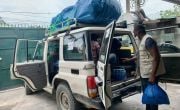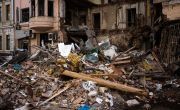
Knowledge Hub
When disaster strikes, Concern responds rapidly, ensuring local priorities guide our actions. However, our work goes beyond the immediate aftermath of a disaster. This piece delves into exactly how we respond to humanitarian crises.
When we talk about humanitarian crises, we are referring to three main possibilities:
- natural disasters
- man-made emergencies
- complex emergencies
These include disasters such as earthquakes and hurricanes, as well as emergencies such as famine caused by conflict. When an emergency arises, we seek out the most vulnerable and hardest-to-reach communities to meet their immediate needs and work with them to design innovative, fast, and effective responses. We then stay with them to help rebuild their lives and to ensure that they are more able to cope with future crises.
How do we respond to an emergency?
In 2020, we responded to 78 different emergencies in 23 countries, reaching 17.9 million people. However, there are a number of approaches we adopt in order to ensure our response is as effective as possible.
Rapid response
One of the main objectives of our emergency programming is to respond rapidly to crises in order to save lives and reduce suffering. While the details from one emergency to the next may change, the core principles remain the same:
- Assess the needs of impacted community, while ensuring the safety of our local staff
- Plan a response to meet the needs of those affected, coordinating with partners including the UN, international governments, and other NGOs
- Deliver timely, coordinated assistance to crisis-affected communities impartially regardless of nationality, race, gender, religion, political opinion, or class
- Track funds dedicated to the emergency response to ensure that they are meeting the needs those affected
- Work alongside the community during the immediate aftermath of an emergency, staying until the community fully recovers and has built resilience against future crises
- Train fellow humanitarians to strengthen future emergency response through our capacity building programmes like Building a Better Response (BBR)

On August 14, 2021, an earthquake of 7.2 magnitude struck Haiti, leaving over 2,200 dead, 12,000 injured and over 650,000 people in need of humanitarian aid. We ramped up our aid distribution operations to reach the thousands of people left homeless.
Initially, we assessed the immediate needs of local communities and were ready to respond where needed. We then began the distribution of shelter and hygiene kits. We also provided cash transfers to 1,000 households. We then launched a mass media campaign via SMS on safe behaviour to conduct during aftershocks. 40,000 SMS messages were sent to affected populations. These SMS messages contained Department of Civil Protection-approved messages on best practices in the event of an aftershock, flooding, or other natural disasters.



Read more about the emergencies we responded to last year
Disaster risk reduction
Disaster risk reduction is central to our work in building community resilience when emergencies hit. After the immediate priorities are tackled, we work with communities to thoroughly identify, analyse, and reduce the risks of future disasters and emergencies. Our teams work to reduce the impact of natural disasters, as well as the human and environmental factors that trigger them.
Risk is a fundamental element that can force people into poverty and keep them trapped in a vicious cycle. All of the communities that we work with are subject to differing degrees of disaster risk, so therefore all of our programmes incorporate disaster risk reduction.
Community resilience
Part of our humanitarian response aims to help communities withstand emergencies and to support them become less vulnerable to future problems. This is particularly important as most regions we work in experience frequent natural disasters or ongoing political instability.
We position ourselves in some of the most vulnerable places in the world so that we are there before disaster strikes. We are able to detect when a situation is deteriorating and respond with tailored interventions. We help to equip families with the skills and tools to feed and support themselves sustainably without resorting to negative coping strategies, such as selling essential assets, migrating for work, or child labour.
Current emergency responses
Ukraine
Since the crisis in Ukraine began, nearly 30% of the country’s population is displaced, and another 30% are stranded in conflict zones. Initially, we deployed a small emergency response team to Krakow, Poland, working in tandem with local organisations, our Alliance2015 partners, and the UN. On the border between Ukraine and Moldova, Concern’s humanitarian partners are providing hot meals, hygiene materials, SIM cards, psychosocial information support, and transportation to people fleeing the violence.



Having conducted initial assessments on the borders with Poland, Moldova, Hungary, Slovakia, and Romania, Concern’s focus is now turning to inside Ukraine, where we feel the needs are greatest. The assistance we are providing includes:
- Delivering food, hygiene items, trauma kits, nappies, sleeping bags, and mats into Ukraine
- Providing essential supplies and support to internally-displaced families in Ukraine; access to clean water; psychosocial support for those traumatised by conflict and displacement through a telephone hotline.
- Supporting Ukrainian people at border crossings by providing food to, assisting with building toilets and heated tents, and providing hygiene supplies such as toothbrushes, toothpaste, shower gel, shampoo, and sanitary products.
Horn of Africa drought

One of the worst droughts in a generation is currently unfolding in the Horn of Africa. Over 15 million people across Somalia, Ethiopia, and Kenya - about half of them children - are already on the verge of starvation. The drought will be catastrophic for affected families already living in extreme poverty.
Many harvests have failed and millions of livestock are emaciated or dead. Families are taking desperate measures to survive, with thousands fleeing their homes in search of food, water and pasture. Moreover, the current conflict in Ukraine has exacerbated the situation.
Despite successful resilience-building efforts across the region, communities have been finding it harder to recover between the increasingly frequent and severe droughts - three in the past ten years alone. This, compounded by Covid-19, locusts and conflict has meant that the vulnerable have little space to recover and bounce back.
Currently, we are:
- Treating tens of thousands of children and adults suffering from severe malnutrition and other illnesses.
- Providing emergency water to areas most in need.
- Providing cash to families so they can buy food and other essential items.
- Repairing broken boreholes and shallow wells.
- Vaccinating livestock against diseases.
Help us continue our work responding to emergencies worldwide
Our impact in 2024
people reached, in 27 of the world's most fragile places
people supported in 50 emergencies
people reached through our health and nutrition programmes
Other ways to help
Donate now
Give a one-off, or a monthly, donation today.
Join an event
From mountain trekking to marathon running, join us for one of our many exciting outdoor events!
Buy a gift
With an extensive range of alternative gifts, we have something to suit everybody.
Leave a gift in your will
Leave the world a better place with a life-changing legacy.
Become a corporate supporter
We partner with a range of organisations that share our passion and the results have been fantastic.
Create your own fundraising event
Raise money for Concern by organising your own charity fundraising event.





